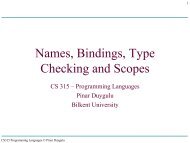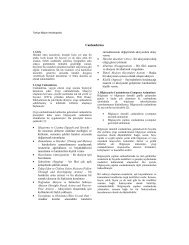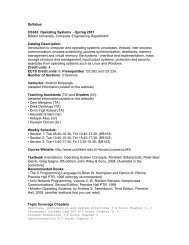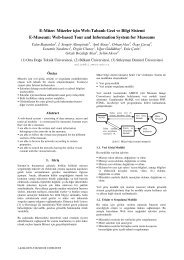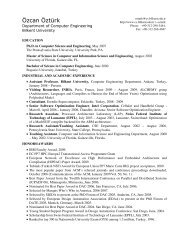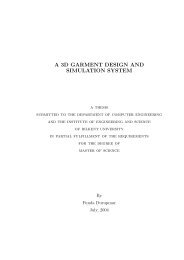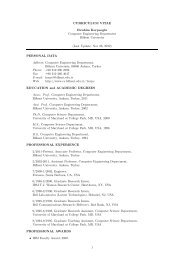questions/solutions - Bilkent University
questions/solutions - Bilkent University
questions/solutions - Bilkent University
Create successful ePaper yourself
Turn your PDF publications into a flip-book with our unique Google optimized e-Paper software.
CS 351: Data Organization and Management, Fall 2010, Midterm p. 4<br />
Q3. (22 pts.) Consider a linear hashing file environment. The file contains 386 primary area<br />
disk blocks. The boundary value is equal to 130. The current load factor of the file is 2/3.<br />
The desired load factor of the file is also 2/3. The blocking factor is 12. The following hash<br />
function is used to distribute the records among the blocks: Mod (key, 7500)<br />
a. How many bits do we need to use to find the location of a record in this file?<br />
h = ⌊log (number of primary disk blocks)⌋ = ⌊log (386)⌋ = 8<br />
If record’s last h bits are less than bv, then we look at last (h-1) = 9 bits.<br />
Otherwise, look at h = 8 bits.<br />
b. How many disk blocks are at the hashing level h?<br />
Blocks at level h are placed between bv and 2 h -1: [bv, 2 h -1]<br />
Then; [130, 2 8 - 1] = [130, 255] = 255-130+1 = 126 blocks<br />
c. How many disk blocks are at the hashing level h+1?<br />
(Number of blocks at level h+1)<br />
= (Total number of blocks) – (Number of blocks at level h)<br />
= 386 – 126 = 260 blocks<br />
or<br />
2 * bv = 2 * 130 = 260 blocks<br />
d. How many records are stored in the file?<br />
Lf = (Number of records in file) / (Number of record positions in prime area)<br />
=> (Number of records in file) = Lf * (Number of record positions in prime area)<br />
(Number of records in file) = 2/3 * (386 * 12)<br />
= 3088 records<br />
e. What can be said about the number of overflow blocks?<br />
We can not state anything on the number of overflow blocks.<br />
f. Assume that we want to insert a record with a key value equal to 150880. In which<br />
block are we going to try to insert this record? Express the block number in binary<br />
form and show your work.<br />
Hash function: Mod( record, 7500)<br />
Mod( 150880, 7500) = 880 is 1101110000 in binary.<br />
Look at last h=8 bits and compare with bv: (01110000=112) < 130<br />
which means use (h+1)=9 bits. Insert into block number: 101110000<br />
g. Now assume that 20 records are inserted to the file. What are the new values for h<br />
and bv? Explain your answer.<br />
We know that we expand for each (Lf * Bkfr) = (2/3 * 12) = 8 records inserted.<br />
20 records = 8 + 8 + 4<br />
which means 2 times we expand; then bv becomes 130 + 2 = 132<br />
h does not change.




